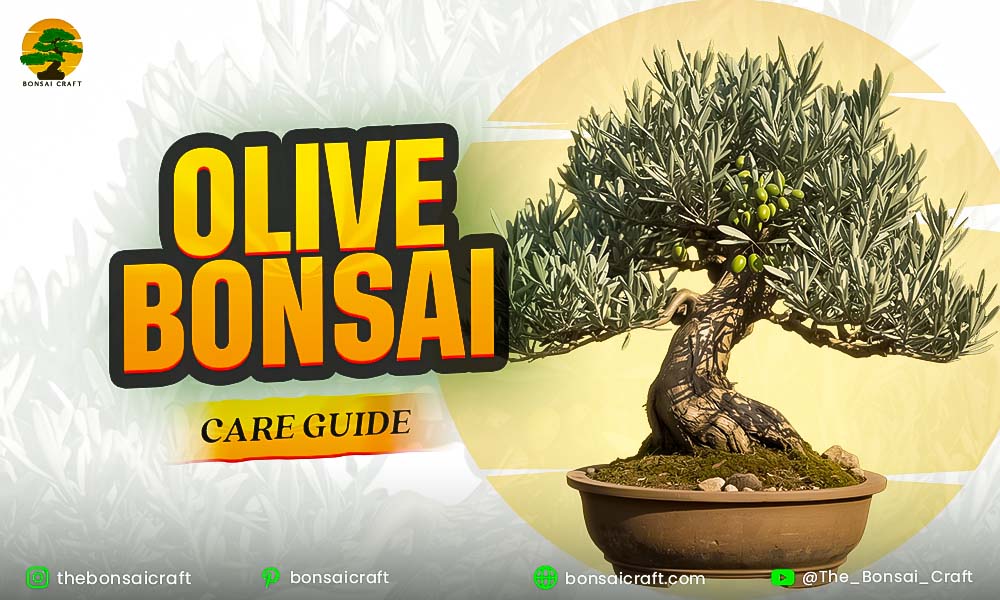
The Olive Tree Bonsai isn’t just a miniature plant — it’s a living symbol of peace, longevity, and wisdom. Native to the Mediterranean region, olive trees have been cultivated for over 6,000 years. When trained as a bonsai, they bring timeless beauty and resilience into your home or garden.
Whether you’re growing a bonsai olive tree indoors or shaping a stunning European olive bonsai, this guide covers every detail — from soil and watering to pruning and repotting. By the end, you’ll know exactly how to care for olive bonsai trees like an expert.
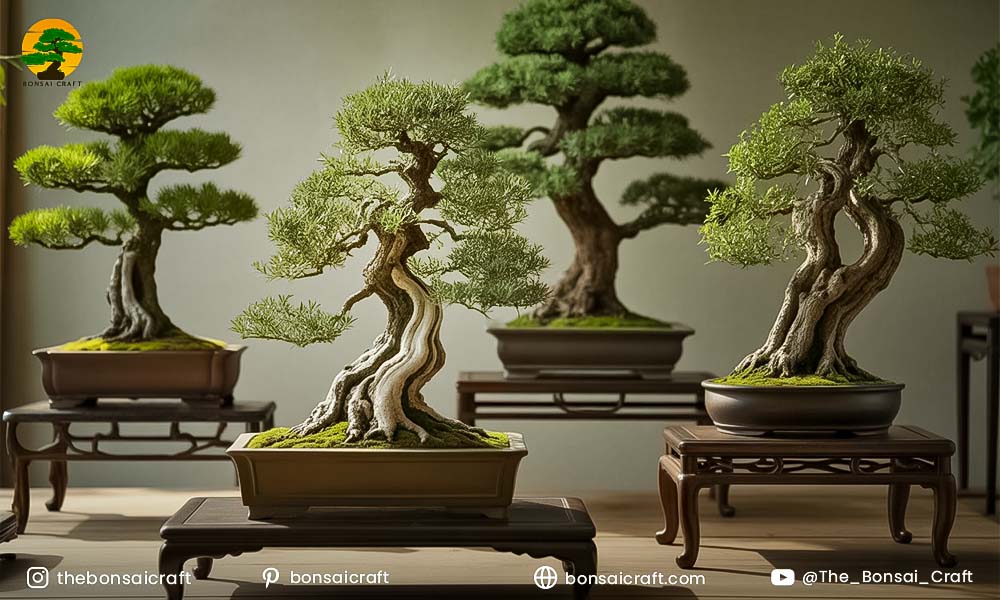
The Olive Tree Bonsai is a timeless symbol of peace and resilience — a perfect choice for bonsai lovers who value beauty and history.
Why Choose an Olive Tree Bonsai?
- The species Olea europaea is native to the Mediterranean region, and is one of the oldest cultivated fruit-trees in the world.
- Some olive trees live for hundreds or even thousands of years in natural conditions, attesting to their hardiness. For example, the “Olive Tree of Mouchão” in Portugal is estimated to be ~3,350 years old.
- Olive bonsai trees display beautiful gnarled trunks, small leaves (especially in wild forms), and form dramatic aged appearances—very desirable in bonsai art.
- They tolerate drought and less-frequent watering once established, making them more forgiving than many tropical bonsai species.
Because of those features, the olive tree bonsai is an excellent choice both for intermediate bonsai hobbyists and for those who want a long-term living piece of art.
Types & Varieties of Olive Bonsai
To train or care for an olive bonsai, it helps to know the variety you’re dealing with. Here are key types:
| Variety | Scientific Name | Key Features |
| European Olive Bonsai | Olea europaea | Classic cultivar, slightly larger leaves, historically fruit-oriented. |
| Wild Olive Bonsai | Olea europaea (sylvestris) or Olea oleaster | Smaller leaves, denser ramification, excellent for bonsai styling. |
| Indoor/Dwarf Cultivars | – | Selected cultivars adapted for pot culture and indoor life; need brighter light. |
Pro tip: If you’re new to this species, aim for a wild olive bonsai or small-leaf cultivar—they’ll be easier to manage for bonsai scale and branch development.
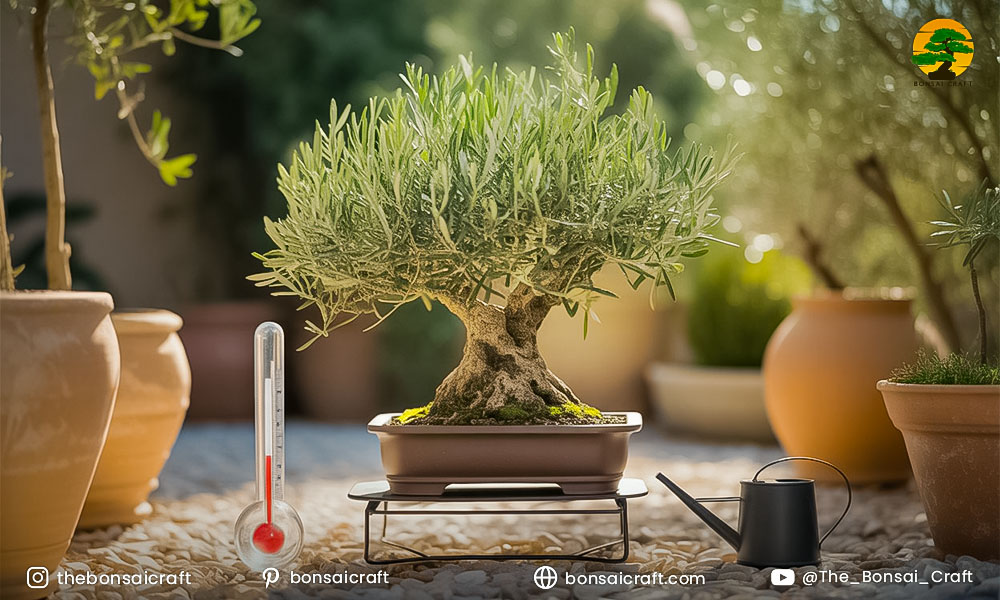
Olive Bonsai thrives best in bright sunlight, airy spaces, and well-draining soil that mimics its Mediterranean roots.
Ideal Growing Conditions for Olive Bonsai
Light Requirements
- Olive bonsai need full sun, ideally 6 + hours of direct sunlight daily.
- If grown indoors (indoor olive tree bonsai), place it next to a south-facing window or supplement with a grow light.
- Too little light leads to large internodes and weak branch structure.
Temperature & Humidity
- Olive trees thrive with warm summers and mild winters. They often grow outdoors in USDA zones 8-10.
- They are slow-growing: “The olive tree grows very slowly but can become several hundred or even a thousand years old.”
- In colder climates, you may keep the bonsai in a cold-but-frost-free greenhouse during winter.
- Moderate humidity is acceptable, but avoid extremely humid, stagnant indoor air—good air circulation is beneficial.
Air Circulation
- Olive bonsai appreciate fresh air. Especially when kept indoors, surface moisture and poor airflow can lead to scale insects or fungal disease.
- Outdoors in warm season is ideal; during colder months, move to a sheltered but ventilated area.
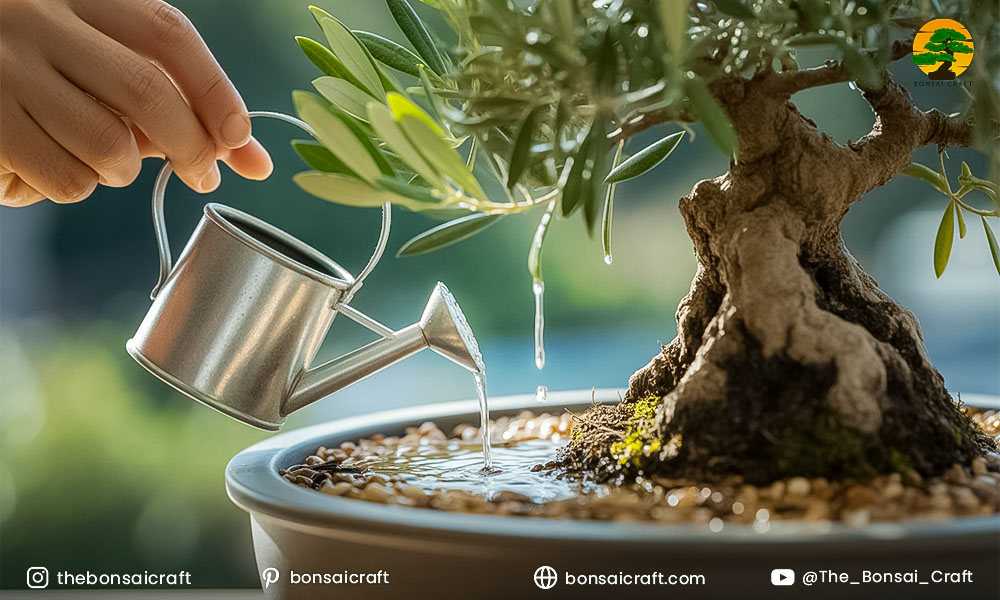
Keep your Olive Tree Bonsai hydrated but never overwatered — consistent moisture helps maintain lush, healthy foliage.
Watering & Moisture Management
Key takeaway: Olive bonsai prefer to dry slightly between waterings rather than remain soggy.
Watering Frequency
- During the active growing season (spring to early autumn), check the soil daily or even twice daily in hot weather. Many practitioners report watering once per day when the top of the soil feels dry.
- In winter, watering may drop to once every 5-7 days, depending on indoor/outdoor conditions.
- Always check: when the top ~1 inch (2–3 cm) of soil is dry, water thoroughly until water drains through pot holes.
Watering Tips
- Use room temperature water, avoiding cold shock.
- Ensure excellent drainage; bonsai pots should have multiple drainage holes and ideally a mesh to prevent blockage.
- Consider using a pebble tray for humidity under indoor specimens—but do not let the root base sit in stagnant water.
Expert Insight
Experienced bonsai growers of olive species emphasise that over-watering is a more common error than under-watering—especially given that olive trees evolved in drought-prone, Mediterranean soils. A slightly drier cycle encourages root health, aeration, and trunk maturity.
Soil & Root Care: Best Soil Mix for Olive Bonsai
Why Soil Matters
Good soil for any bonsai must balance drainage, moisture retention, and aeration. For an olive bonsai, this is particularly important because olive roots dislike water-logged conditions.
Recommended Soil Components
A typical mix for olive bonsai would include:
- Akadama (~40%): holds moisture and nutrients, aids root structure.
- Pumice (~30%): excellent drainage, retains some moisture.
- Lava rock / coarse grit (~30%): promotes aeration and prevents compaction.
This type of mix or a similar free-draining substrate is recommended by bonsai specialists.
Soil pH & Conditions
- Olive trees prefer a slightly alkaline soil pH (around 7-8) when in bonsai container culture.
- Avoid heavy clay or peat-rich mixes which retain too much moisture.
Repotting & Root Health
We’ll cover full repotting details later, but in short: every 2-3 years (or longer for older trees) repot into fresh well-draining soil, prune roots carefully, and avoid heavy fertiliser or watering until new roots establish.
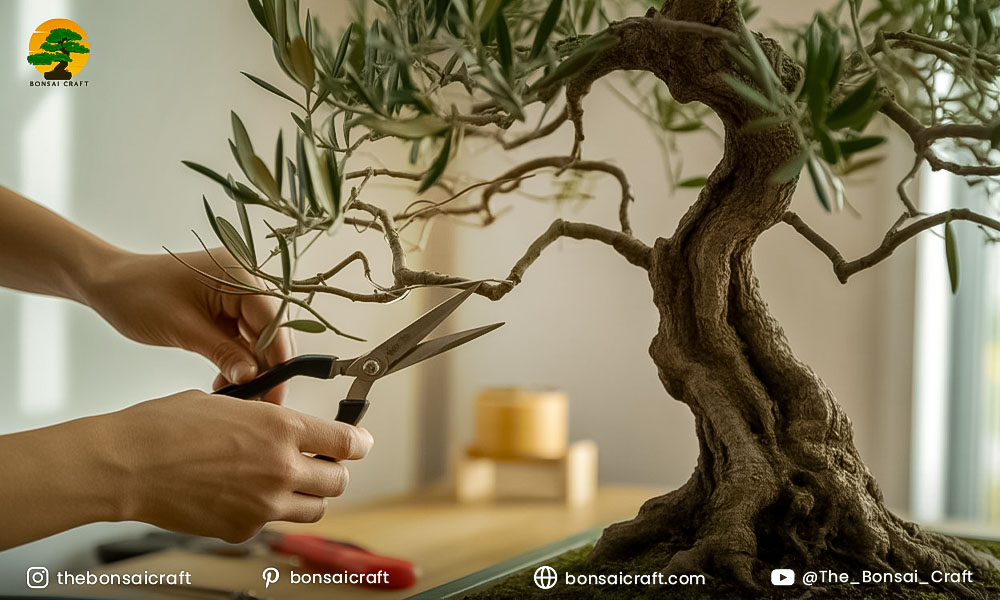
Regular pruning helps shape your Olive Bonsai into a balanced and artistic form, showcasing its elegant branches and fine leaves.
Pruning & Shaping Olive Tree Bonsai
Pruning is where your skill and artistry turn an olive sapling into a refined bonsai.
Structural Pruning (Major)
- Best done in late spring to early summer, when the tree is actively growing and can recover well.
- Remove large, crossing branches; re-establish trunk lines; open the canopy to improve light and airflow.
- When wiring, use aluminium or annealed copper wire carefully; olive bark can be relatively soft and is prone to damage if wired too tightly.
Maintenance Pruning
- During the growing season, pinch back new shoots once they develop 6-8 leaves.
- Remove any weak or sterile branches. This encourages the bonsai olive tree to ramify (develop finer branches) and keeps the scale appropriate.
- After root pruning/repotting, delay major branch work until the tree shows signs of recovery.
Styling the Olive Bonsai
- Olive bonsai is suitable for many styles: formal upright (Chokkan), informal upright (Moyogi), slanting (Shakan), twin-trunk (Sokan), even broom styles.
- Wild olive forms, with natural deadwood (jin/shari), are particularly striking for advanced layouts.
Fertilising Olive Bonsai
Proper nutrition supports healthy foliage, strong trunks and branches, and overall vigor.
Fertiliser Schedule
- Spring to early summer: Use a balanced organic fertiliser (e.g., N-P-K 10-10-10) every 2–4 weeks.
- Late summer to autumn: Move to a low nitrogen fertiliser to help harden growth and prepare for winter dormancy.
- Winter: Minimal or no fertilisation—only apply lightly if growth is ongoing indoors.
Application Tips
- Use liquid bonsai fertiliser diluted to half strength for newly repotted trees.
- Avoid fertilising when soil is extremely dry or when the tree is under stress (e.g., after major wiring or root work).
- Organic fertilisers (e.g., fish emulsion, compost tea) help soil micro-life and root health.
Repotting: When & How to Repot Olive Bonsai
When to Repot
- Young trees: every 2 to 3 years.
- Mature trees: every 3 to 5 years or longer if root-bound.
- Best time: late spring (after last frost) when root growth is active. Waiting until too late may stress the tree.
How to Repot (Step-by-Step)
- Remove the tree from its pot gently, shake off old soil.
- Prune approximately one-third of the roots, focusing on large roots and over-long root masses.
- Provide a drainage mesh at pot base; place fresh bonsai soil mix.
- Plant the tree at the same depth or slightly higher than before to prevent root crown rot.
- Water thoroughly to settle soil. Keep in partial shade for about a week until the tree recovers.
- Delay fertilisation until new growth appears (usually 4–6 weeks).
Why It Matters
Olive bonsai trees naturally produce strong roots even after excavation or major pruning, which makes them well-suited to bonsai repotting—but only with good cultivation of root health.
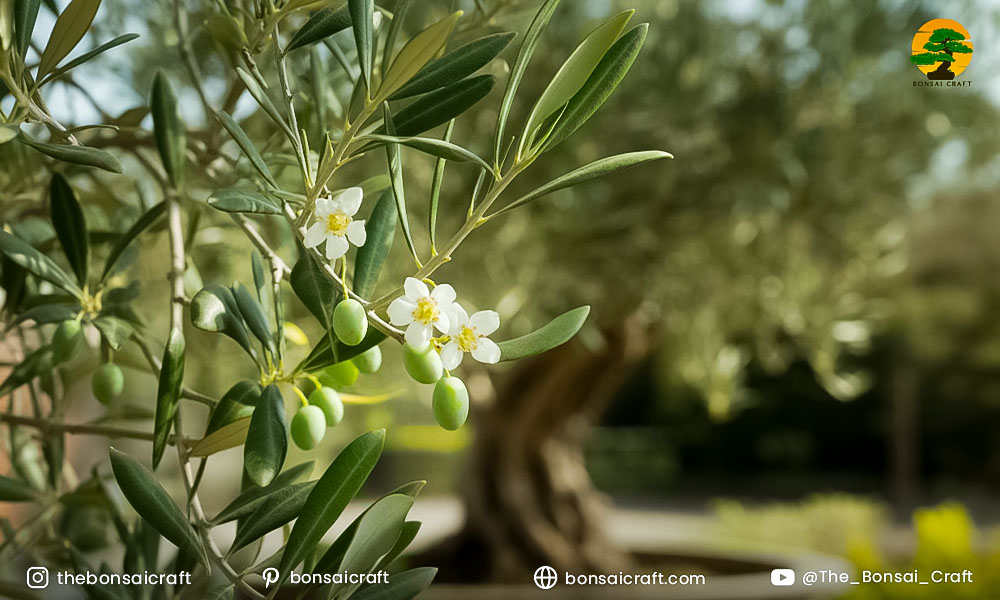
Close-up of Olive Tree Bonsai producing small white flowers and tiny developing olives
Flowering & Fruiting in Olive Bonsai
- The olive tree produces small yellow-white flowers in late spring. The resulting olives (drupes) appear green and later turn black/violet. While bonsai-sized trees may not always fruit heavily (due to pot size, root volume, indoor conditions), many healthy bonsai will produce small olives if given strong light and proper nutrition.
- If you do get fruit, you may need to thin the fruit to avoid undue stress on the tree.
Indoor vs Outdoor Olive Tree Bonsai
Outdoor Growth
- Preferred: full sunlight, natural air circulation, moderate watering.
- Best suited for climates where winter is mild or where the tree can be moved to a cool shelter.
Indoor Growth
- Possible—but more challenging. You will need:
- Outstanding light (south-facing window or strong LED grow light).
- Good drainage and air circulation.
- Keep indoor humidity moderate; avoid stagnant rooms.
- Protect from overhead heating/AC which can dry out the tree.
- As an indoor olive bonsai, growth is typically slower and styling options may be limited compared to outdoor growth.
Recommendation
If you can, keep your bonsai olive outdoors during warm months, and bring indoors only during frost or extreme cold. This gives the tree optimal conditions for vigor and health.
Common Olive Tree Bonsai Problems & Solutions
| Issue | Likely Cause | Solution |
| Yellow or dropping leaves | Over-watering or poor drainage | Check soil, improve drainage, reduce watering |
| Sparse growth / large internodes | Insufficient light | Move to brighter light, prune to encourage ramification |
| Scale insects / mealybugs | Warm indoor conditions, stagnant air | Improve airflow, treat with neem oil or insecticidal soap |
| Root rot or fungal issues | Heavy, compact soil; too much watering | Repot into free-draining mix, prune damaged roots |
| Frost damage | Outdoor exposure below freezing | Move to sheltered area or greenhouse, use cold-tolerant pot materials |
Expert Tip: A well-cultivated olive bonsai is surprisingly pest-resistant, but poor environmental conditions quickly lower its natural resilience.
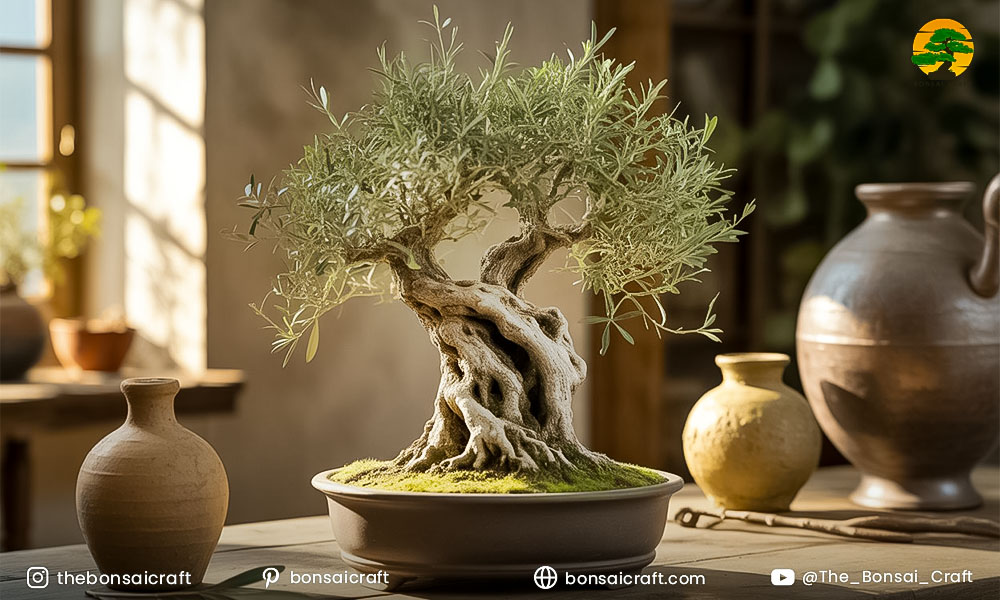
From upright to cascading styles, Olive Tree Bonsai designs express harmony between nature, art, and patience.
Olive Tree Bonsai Styles & Artistic Considerations
Because olive bonsai respond well to deadwood treatments, gnarled trunks and bonsai expression, you have many style options:
- Formal Upright (Chokkan): Straight trunk, symmetrical, dignified.
- Informal Upright (Moyogi): Graceful curves, classic bonsai look.
- Slanting (Shakan): Trunk leans, evokes struggle/adversity.
- Twin Trunk (Sokan): Two trunks from one root, balanced composition.
- Deadwood (Sharimiki/Jin): Olive’s hard wood allows dramatic deadwood features.
When choosing your style, consider leaf size, branch density, trunk movement, and whether you want fruit or not. Wild-olive forms with tiny leaves suit smaller bonsai; large-leaf cultivars may be better for mid-sized bonsai.
How to Make an Olive Tree Bonsai (From Scratch)
- Select a healthy olive seedling or cutting (preferably a bonsai-appropriate cultivar).
- Plant in a shallow bonsai pot with the aforementioned well-draining soil.
- Provide full sun, good drainage, and mild water stress to promote trunk thickening.
- After 1–2 years of growth, begin basic shaping: structural pruning, establishing main trunk lines, wiring.
- Transition to maintenance pruning each season: pinch new growth, refine branches, wire as needed.
- Every 2–3 years repot the tree into fresh soil, pruning roots each time.
- Over 3–5 years you will develop foliage pads, branching structure, trunk character. Patience and consistency are key.
Real-world example: bonsai outlets selling 15-year-old field-grown olive bonsai show how trunk character develops gradually. Image-based example: many olive bonsai field-grown for 10+ years before being styled.
Seasonal Care Calendar
| Season | Tasks |
| Spring | Move outdoors (if applicable), structural pruning, repot if needed, resume regular watering and fertilising. |
| Summer | Ensure full sun exposure, water deeply, shade in extreme heat, continue maintenance pruning. |
| Autumn | Gradually reduce watering, switch to low-nitrogen fertiliser, monitor pests, begin preparing for dormancy if outdoors. |
| Winter | If outdoors, ensure frost protection; if indoors, place in bright, cool spot; minimal fertiliser; check soil periodically. |
Conclusion
Growing a Olive Tree Bonsai (olive bonsai) requires patience, proper light, drainage, and care—but it rewards with long-lived beauty, symbolic presence, and bonsai-style character that few other species match. From the deep history of the Mediterranean olive to the miniaturised form you shape today, you’re creating a living artwork and connection with nature’s resilience. Stick to consistent watering, good soil, bright light, and periodic pruning/repotting; your bonsai olive tree will thrive and age gracefully.
Frequently Asked Questions (FAQs)
How do you care for Olive Tree Bonsai indoors?
Keep your indoor olive tree bonsai near a south-facing window with 6 hours of sunlight daily. Use well-draining olive bonsai soil, water when the top inch is dry, and fertilize every 2–4 weeks in the growing season.
When should I repot my Olive Bonsai?
Repot your olive bonsai every 2–3 years in late spring. Trim 30% of the roots and use fresh, free-draining soil to encourage new growth.
Can Olive Bonsai trees bear fruit?
Yes! With enough sunlight and good pollination, mature olive bonsai trees can produce tiny olives during summer.
What is the best fertilizer for Olive Bonsai?
Use a balanced organic fertilizer (10-10-10) during spring and summer, reducing nitrogen in fall to prepare for dormancy.
How long does an Olive Bonsai live?
With proper care, an Olive Tree Bonsai can live over 100 years, symbolizing endurance and peace across generations.
